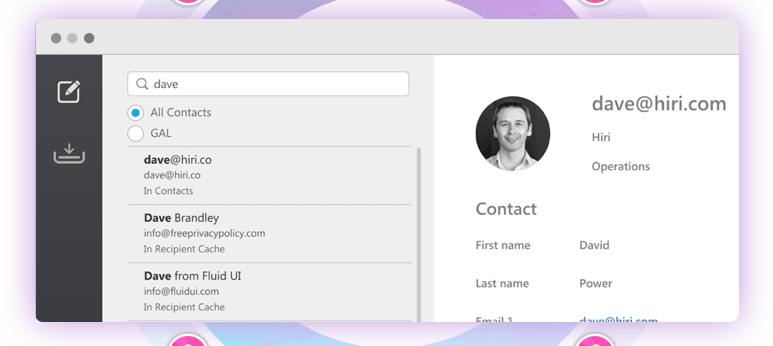Warning!
Despite being a promising application, it seems Hiri is not actively developed and maintained even for paid customers. The developers seem to be unreachable. You have been warned!
Previously, I have written about the email services Protonmail and Tutanota on It’s FOSS. And though I liked both of those email providers very much, some of us couldn’t possibly use these email services exclusively. If you are like me and you have an email address provided for you by your work, then you understand what I am talking about.
Some of us use Thunderbird for these types of use cases, while others of us use something like Geary or even Mailspring. But for those of us who have to deal with Microsoft Exchange Servers, none of these offer seamless solutions on Linux for our work needs.
This is where Hiri comes in. We have already featured Hiri on our list of best email clients for Linux, but we thought it was about time for an in-depth review.
FYI
Hiri is neither free nor open source software.
Reviewing Hiri email client on Linux

According to their website, Hiri not only supports Microsoft Exchange and Office 365 accounts, it was exclusively “built for the Microsoft email ecosystem.”
Based in Dublin, Ireland, Hiri has raised $2 million in funding. They have been in the business for almost five years but started supporting Linux only last year. The support for Linux has brought Hiri a considerable amount of success.
I have been using Hiri for a week as of yesterday, and I have to say, I have been very pleased with my experience…for the most part.
[irp posts=”25352″ name=”ProtonMail: An Open Source Privacy-Focused Email Service Provider”]
Hiri features
Some of the main features of Hiri are:
- Cross-platform application available for Linux, macOS and Windows
- Supports only Office 365, Outlook and Microsoft Exchange for now
- Clean and intuitive UI
- Action filters
- Reminders
- Skills: Plugins to make you more productive with your emails
- Office 365 and Exchange and other Calendar Sync
- Compatible with Active Directory
- Offline email access
- Secure (it doesn’t send data to any third party server, it’s just an email client)
- Compatible with Microsoft’s archiving tool
Taking a look at Hiri Features

Hiri can either be compiled manually or installed easily as Snap and comes jam-packed with useful features. But, if you knew me at all, you would know that usually, a robust feature list is not a huge selling point for me. As a self-proclaimed minimalist, I tend to believe the simpler option is often the better option, and the less “fluff” there is surrounding a product, the easier it is to get to the part that really matters. Admittedly, this is not always the case. For example, KDE’s Plasma desktop is known for its excessive amount of tweaks and features and I am still a huge Plasma fan. But in Hiri’s case, it has what feels like the perfect feature set and in no way feels convoluted or confusing.
That is partially due to the way that Hiri works. If I had to put it into my own words, I would say that Hiri feels almost modular. It does this by utilizing what Hiri calls the Skill Center. Here you can add or remove functionality in Hiri at the flip of a switch. This includes the ability to add tasks, delegate action items to other people, set reminders, and even enables the user to create better subject lines. None of which are required, but each of which adds something to Hiri that no other email client has done as well.
Using these features can help you organize your email like never before. The Dashboard feature allows you to monitor your time spent working on emails, the Task List enables you to stay on track, the Action/FYI feature allows you to tag your emails as needed to help you cipher through a messy inbox, and the Zero Inbox feature helps the user keep their inbox count at a minimum once they have sorted through the nonsense. And as someone who is an avid Inbox Zeroer (if that is even a thing), this to me was incredibly useful.
Hiri also syncs with your associated calendars as you would expect, and it even allows a global search for all of the other accounts associated with your office. Need to email Frank Smith in Human Resources but can’t remember his email address? No big deal! Hiri will auto-fill the email address once you start typing in his name just like in a native Outlook client.
Multiple account support is also available in Hiri. The support for IMAP will be added in a few months.
In short, Hiri’s feature-set allows for what feels like a truly native Microsoft offering on Linux. It is clean, simple enough, and allows someone with my productivity workflow to thrive. I really dig what Hiri has to offer, and it’s as simple as that.
[irp posts=”27249″ name=”Tutanota: Encrypted Open Source Email Service for Privacy Minded People”]
Experiencing the Hiri UI
As far as design goes, Hiri gets a solid A from me. I never felt like I was using something outdated looking like Evolution (I know people like Evolution a lot, but to say it is clean and modern is a lie), it never felt overly complicated like KMail, and it felt less cramped than Thunderbird. Though I love Thunderbird dearly, the inbox list is just a little too small to feel like I can really cipher through my emails in a decent amount of time. Hiri seemingly fixes this but adds another issue that may be even worse.

Geary is an email client that I think does layouts just right. It is spacious, but not in a wasteful way, it is clean, simple, and allows me to get from point A to point B quickly. Hiri, on the other hand, falls just shy of layout heaven. Though the inbox list looks fantastic, when you click to read an email it takes up the whole screen. Whereas Geary or Thunderbird can be set up to have the user’s list of emails on the left and opened emails in the same window on the right, which is my preferred way to read email, Hiri does not allow this functionality. The layout either looks and functions like it belongs on a mobile device, or the email preview is below the email list instead of to the right. This isn’t a make or break issue for me, but I will be honest and say I really don’t like it.
In my opinion, Hiri could work even better with a couple of tweaks. But that opinion is just that, an opinion. Hiri is modern, clean, and intuitive enough, I am just obnoxiously picky. Other than that, the color palette is beautiful, the soft edges are pretty stunning, and Hiri’s overall design language is a breath of fresh air in the, at times, outdated feel that is oh so common in the Linux application world.
Also, this isn’t Hiri’s fault but since I installed the Hiri snap it still has the same cursor theme issue that many other snaps suffer from, which drives me UP A WALL when I move in and out of the application, so there’s that.
[irp posts=”13640″ name=”Top 9 Best Email Clients for Linux”]
How much does Hiri cost?

Hiri is neither free nor open source software. Hiri costs either up to $39 a year or $119 for a lifetime license. However, it does provide a free seven day trial period.
Considering the features it provides, Hiri is a good product even if you don’t have to deal with Microsoft Exchange Servers. Don’t take my word for it. Give Hiri a try for free for the seven day trial and see for yourself if it is worth paying or not.
And if you decide to purchase it, I have further good news for you. Hiri team has agreed to provide an exclusive 60% discount to It’s FOSS readers. All you have to do is to use coupon code ITSFOSS60 at checkout.
Get 60% Off with ITSFOSS60 Coupon Code
Conclusion
In the end, Hiri is an amazingly beautiful piece of software that checks so many boxes for me. That being said, the three marks that it misses for me are collectively too big to overlook: the layout, the cost, and the freedom (or lack thereof). If you are someone who is really in need of a native client, the layout does not bother you, you can justify spending some money, and you don’t want or need it to be FOSS, then you may have just found your new email client!


